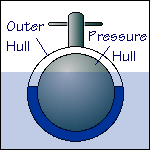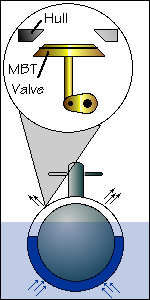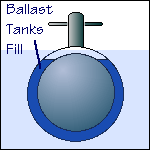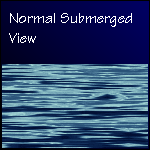Diving the Submarine
 A submarine is basically composed of two long steel tubes, one
inside the other. The internal structure is called the pressure
hull, and it separates the ocean from the crew's environment.
It is constructed of a thick steel that has a high yield strength
to withstand the enormous force of the ocean when the boat is
submerged. The outer hull creates the external shape and forms
the ballast tanks.
A submarine is basically composed of two long steel tubes, one
inside the other. The internal structure is called the pressure
hull, and it separates the ocean from the crew's environment.
It is constructed of a thick steel that has a high yield strength
to withstand the enormous force of the ocean when the boat is
submerged. The outer hull creates the external shape and forms
the ballast tanks.
The ballast tanks, in concert with other tanks internal to the
boat, permit the submarine's crew to change the ship's
buoyancy. Buoyancy is the property of an object that determines
whether it will sink or float. By trapping air in the ballast
tanks, the submarine will be positively buoyant and will float.

Valves on top of the ballast tanks called MBT Vents (for Main
Ballast Tank vents) are opened to release the trapped air. The
pressure of the seawater forces the water into the bottom of the
ballast tanks through open grating. The process of filling up
the ballast tanks causes the submarine to loose buoyance and
become heavy, or negatively buoyant, and the ship will begin to
submerge. Submerging the ship is called Diving, and it
requires the diligence of the entire submarine crew on watch.
The watchstanders are all carefully monitoring system behaviors
to ensure an emergency does not arise. The Commanding Officer
gives permission to dive the submarine.

Once the ballast tanks are completely emptied of air, and the
submarine goes to a predetermined depth, the main ballast tank
vents are shut. This is very important because in the event the
ship must be surfaced in an emergency, air under high pressure is
forced into the ballast tanks to create positive buoyancy. If
these valves were left open, all the vital air would escape
out the open vents.

At this point, a submarine is now operating in its optimum environment.
Because it is a cylinder, a submarine is not that stable on the
surface. Once submerged though, there is very little wave action
or rocking back and forth. The final view is that of a submerged
submarine -- get the point?
 A submarine is basically composed of two long steel tubes, one
inside the other. The internal structure is called the pressure
hull, and it separates the ocean from the crew's environment.
It is constructed of a thick steel that has a high yield strength
to withstand the enormous force of the ocean when the boat is
submerged. The outer hull creates the external shape and forms
the ballast tanks.
A submarine is basically composed of two long steel tubes, one
inside the other. The internal structure is called the pressure
hull, and it separates the ocean from the crew's environment.
It is constructed of a thick steel that has a high yield strength
to withstand the enormous force of the ocean when the boat is
submerged. The outer hull creates the external shape and forms
the ballast tanks.


